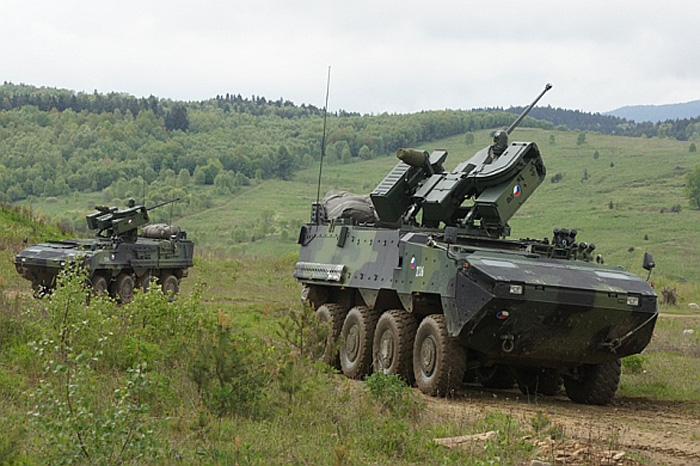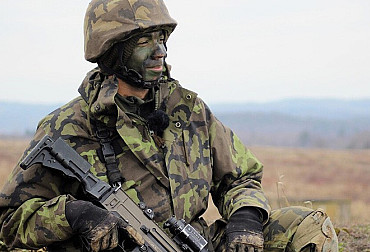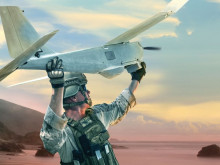Modernisation of wheeled IFVs Pandur II 8x8 CZ: 30 or 35 mm calibre? The Czech Army has long preferred the smaller calibre
"Another topic that resonates across the Army," General Stepanek, commander of the 4th Rapid Deployment Brigade, said in a recent interview in response to a question about the preference between 30 mm and 35 mm calibre for the main weapon of the Pandur II 8x8 wheeled armoured vehicles. And it is also a topic that comes up in the context of tracked armoured vehicles, and not only because in Slovakia, as part of the acquisition of CV90 tracked infantry fighting vehicles, the local army reached for the larger 35mm calibre. It is often claimed that the larger calibre of the main weapon of armoured vehicles is a trend in the world, but like any other parameter of combat equipment, there are of course pros and cons, and it is always necessary to find a suitable compromise between the size of the vehicle, its weight, the calibre of the weapon, the types of ammunition and its quantity.

Picture: Pandur II 8x8 infantry fighting vehicles | Ministry of Defence of the Czech Republic
The most important characteristics of medium calibre (i.e. 20-50 mm) automatic cannons for infantry fighting vehicles on wheeled and tracked chassis are accuracy, armour penetration, effectiveness against infantry and small airborne UAV-type targets, which is an increasingly desirable capability. Depending on the desired effect, depending on the type of target and the ammunition used, rate of fire is then more or less important, and of course, generally the supply of ammunition carried, including the amount of ammunition that can be replenished from supply vehicles.
Thus, not least in view of the rapid development of technologies that affect the effectiveness of projectiles against different targets and the accuracy of fire, it is not at all easy to make decisions at a given point in time that will determine the shape of the armament of the backbone elements of the army for decades to come. One cannot blindly copy abroad, where each army has its own specific reasons for its decisions, but at the same time the development and experience of allied and other armed forces cannot be ignored.
The Army of the Czech Republic has clearly preferred the 30 mm calibre in the case of wheeled and tracked infantry fighting vehicles. In the case of tracked armoured personnel carriers, one of the important arguments was the fact that Pandur II 8x8 CZs from the armament of the 4th Rapid Deployment Brigade is armed with this calibre. Not only the relatively small Czech Armed Forces need rational logistics, and two different calibers for related types of combat equipment are an unnecessary luxury and burden. With the impending modernisation of existing Pandur vehicles, which need a new combat turret/weapon station in the first place, this argument is mirrored, but its content remains the same, and it is not the only one.
Generally speaking, the larger caliber automatic cannon offers greater effectiveness of HE shells, more options in terms of the use of airburst munitions (especially against air targets), and by the design of the cannon itself, in most cases it is also about greater armor penetration, but never to a level to penetrate the frontal armour of MBTs, whereas the side or rear armour of tanks can be penetrated reliably in most cases even by 30mm calibre APFSDS, and the weapon of infantry fighting vehicles against tanks is the ATGM, not the automatic cannon, which is primarily designed to engage infantry, light armour and air targets.
There are advantages and disadvantages to consider, with the disadvantages of larger calibers including, for example, lower cadence, larger and heavier rounds are harder to store, transport, and generally harder to handle. Advantages include, for example, greater range or effect at longer distances. However, the consideration of which calibre to choose cannot be based on one or a few parameters; the system must be evaluated from all possible angles, including its capabilities and how it can be integrated into the chosen platform. And, as we see in the case of the choice for the future Czech tracked IFV, also take into account the existing armament of the armed forces. And to the army, no asset serves itself.
For example, the amount of ammunition carried is one of the crucial parameters, and shows, among other things, that the way it is stored matters a lot. An example is the CV90 tracked IFV, which is operated by a number of European armies with different armaments. The CV9040 (with a 40 mm Bofors gun) carries 234 rounds, of which only 24 are for immediate use (48 total in the turret); the CV9035 (with a 35 mm Bushmaster III gun) carries a total of 203 rounds, fewer than the CV9040, but 35 for immediate use (70 total in the turret); and the CV9030 (Bushmaster II) can carry up to 400 rounds, of which 160 are for immediate use.
Considering the fact that against various targets a 30 mm HE grenade is perfectly adequate, the decision on what ammunition to carry is not simply a matter of the higher effectiveness of the larger calibers. Up to now, the standard weapon of the US IFVs (Bradley M2) is the 25 mm cannon (the vehicle carries a supply of 900 rounds, 300 of which are in the turret). As far as airburst ammunition is concerned, it can be used well from the 30 mm calibre onwards, and in this respect the smaller calibre does not bring a major disadvantage, quite the contrary: small drones are increasing in number over the modern battlefield, and we can thus return to the argument of the amount of ammunition carried.
As already mentioned, Pandur vehicles serving in the Czech Armed Forces currently use a 30 mm cannon. However, the option of rearmament to the 35 mm calibre is also being discussed in public, so our editor, in the context of the aforementioned interview with General Štěpánek, asked what solution he was leaning towards and what effect a possible rearmament to a larger calibre would have on the 4th Rapid Deployment Brigade. A significant factor is the possibility of using the same caliber ammunition for different weapon systems. It is also worth remembering that more important than calibre is the type and effectiveness of the ammunition. A higher caliber does not immediately mean greater destructive effect. Last but not least, the introduction of a larger calibre means increased demands on logistics in terms of transport and storage of ammunition. "I do not see the effectiveness of ammunition in destroying a target in the calibre alone," General Štěpánek responded.
In terms of future upgrades to the Pandur II 8x8 CZ, it is very likely that they will continue to be armed with the 30mm cannon. A similarly important question, and one that was also addressed at the time when the specification of the tracked vehicles was being determined, is whether this weapon should be fitted with a manned or unmanned turret/gun station. For tracked vehicles, the Army opted for a manned turret. In the case of wheeled armoured vehicles, the solution was indicated by Gen. Štěpánek: "...in the event of a malfunction of the weapon system, you need to remove the malfunction as quickly as possible and conduct fire. So a fully automatic system with the possibility of emergency manual mode is what we need." At the same time, he mentioned the need to reduce the silhouette of the vehicle. The wheeled IFV version of the Pandur II is 3.76 m tall in the combat position of the RWCS-30 weapon station. In contrast, the Corsac 8x8 variant with the TURRA 30 turret (also remote-controlled), for example, measures just 2.95 m in height.





















